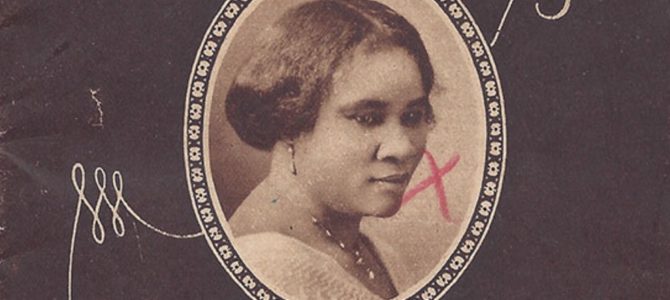
Money is not the only, nor even most important, marker of personal success. But it’s not insignificant when examining the progress and contributions of a historically oppressed minority to society. A notable marker of business success is achieving the status of millionaire. When marking the significant accomplishments of African-American people in the world of industry, determining the first millionaires in that community is as interesting as it is significant.
The first two self-made female millionaires in America were African-American women, and they both have remarkable stories. One is relatively well-known; the other, not so much. Sarah Breedlove, better known by her later-attained business name, Madam C. J. Walker, is usually credited with being the first self-made female millionaire in America.
Madam C.J. Walker’s Incredible Story
Sarah was born into a slave family in Louisiana in 1867, just after the Emancipation Proclamation — so she was technically born free. Orphaned at age 7, she only had three months of real education, which she received through reading and writing lessons in Sunday school. Sarah married at the age of 14 and was widowed six years later. After her second marriage failed, she married an established businessman and changed her name to the notably elegant Madam C. J. Walker.
In her young adulthood, she was determined to earn enough money to give her only daughter, A’Lelia, a much better life, one that afforded a quality education. Over time, by being uncommonly shrewd, clever, and hardworking, she did so beyond her wildest dreams by becoming Mary Kay long before Mary Kay.

She created an extraordinarily successful line of hair care and beauty products for African-Americans from her meager life savings of $1.25. Beyond being owned and run by a black woman born from a slave family, the company’s primary distinguishing feature was its sales model.
It used mail orders, but the most dynamic angle were “Walker’s Agents,” the more than 20,000 women who went door-to-door selling Madam’s line of products. These well-trained women were given a branded uniform of pressed white shirts, neat black skirts, and a black attaché case to reflect their professionalism.

These women spread across the country demonstrating the miraculous “Walker System” for advanced hair care and growth to millions of black women.
While unskilled white male workers were making about $11 a week, Madam’s agents were earning from $5 to $15 a day. That was more than they could make in a month doing kitchen work, and they were their own bosses. They got out what they put into it, making them partners in the business.
This was a remarkable opportunity for uneducated, but highly motivated, African-American women to earn an outstanding and empowering income for their families, often elevating their earning power beyond what their husbands could earn. Madam also ran a school of cosmetology where women could learn the skills needed to open their own beauty shops and use Madam’s products.
In 1917, Walker held the first national gathering of businesswomen in the country in Philadelphia, the Madam C. J. Walker Hair Culturists Union of America, to train and motivate her agents. Prizes were given to the women with the highest sales and the most charitable contributions to community efforts, an activity Walker was deeply involved in and encouraged.
She gave $10,000 a year to help young African-American men and women attend college, and sent six new students to the Tuskegee Institute every year. She was a gracious funder of the NAACP and YMCAs for black youth, as well as many causes fighting racial injustice. She expected her agents to do the same, and they did.
The Madam C. J. Walker Manufacturing Company grew mightily throughout the United States, as well as in the Caribbean and Central America in her lifetime. The brand is still going strong today.
From her great wealth, Walker built many houses and townhomes, but the grandest was Villa Lewaro, at Irvington-on-Hudson, just north of New York City, neighboring John D. Rockefeller’s mansion. She spared no expense in furnishing it as to make any tycoon proud. The New York Times reported that neighbors “gasped in astonishment” that a black women could own such a stunning home. It was so massive she was able to host her subsequent annual company conventions there.
Madam told Booker T. Washington she was not in the business world only to make a life for herself and her employees, “but to do all the good I can for the uplift of my race.” She did in immeasurable ways, in her innovative products themselves, life-lifting and dignity-giving employment opportunities, her philanthropy, as well as her own personal example and message that an African-American woman can build something unbelievable out of just $1.25.
Her obituary in the New York Times announced in its 1919 headline, “Wealthiest Negress Dead” at the young age of 51. The Times noted that “her death recalled the unusual story of how she rose from a washerwoman making only $1.50 a day to a position of wealth and influence among members of her race.” Her influence was far greater than that.

Annie Malone: The True First Female Millionaire
Contrary to most reports, Walker was not the first African-American millionaire. Not even the first female millionaire. That title belongs to the humble but supremely confident Annie Malone. It was Annie who established and built the first international industry inventing, manufacturing, and selling cosmetic and hair care products for black women, doing so under her brand name Poro. She served as a formative mentor to Madam Walker as well as her employer. (Walker decided to break from Malone, becoming her primary competitor after she moved to Denver to open that market for Malone’s Poro line.)
By 1914, Malone reached multimillionaire status while Walker was working hard to get her business off the ground in Indianapolis. In 1916, Malone broke ground on a mammoth four-story corporate headquarters in St. Louis, occupying a full city block. It housed her street-level retail store front and her highly influential Poro College, which taught young African-American women cosmetic skills and life skills such as dignified comportment, professional dress, and social confidence. The musician Chuck Berry graduated from Poro in 1952, along with his two sisters.
The complex also housed a 500-seat auditorium, gymnasium, dining hall, bakery, chapel, and rooftop greenhouses for growing herbs for her products and fruits and vegetables to feed her students. The rest of the complex housed her laboratories, mail rooms, shipping depot, and the factory that produced her large and growing product line. It was an impressive structure by any standard, a small city employing several hundred busy, remarkably industrious, and successful people.
Madam Walker got her agent sales idea from Malone. It was Malone who created the first team of carefully trained and commissioned professional women decades before the Avon model came along. These women were not just sales agents, but skilled beauticians who elaborately demonstrated the products in their customer’s homes. Malone’s business grew internationally, to North and South American, Canada, Africa, and the Philippines, having trained and dispersed some 75,000 Poro agents as well as establishing beauty schools in 32 U.S. cities.

Annie was, in many ways, more philanthropic than the extremely generous Madam. She was far less conspicuous in her spending, lifestyle, and personal promotion, even though she was one of the first Americans to own a Rolls Royce. In fact, it was her quiet nature and reserved public image what allowed her less wealthy mentee to become remembered as the first self-made female millionaire, while Annie and her Poro enterprise is largely unknown.

It is truly incredible that these two poorly educated daughters of slaves founded highly successful and influential industries, growing fabulously rich beyond anyone’s wildest dreams. But even more stunning, they achieved all this in a decade or so, while no white woman or black man ever came close to achieving such a feat at that time.
For the overachieving student, you can learn more:
- Madam Walker: A’Leila Bundles tell the detailed story of her great, great grandmother in this C-SPAN Book TV special.
- Annie Malone: A quick overview of Annie’s life and accomplishments as well as a short St. Louis Public Television documentary.









